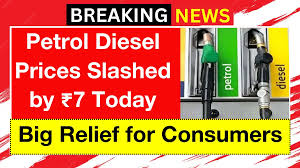Now Reading: Petrol and Diesel Prices Today: A Snapshot of the Energy Market
-
01
Petrol and Diesel Prices Today: A Snapshot of the Energy Market
Petrol and Diesel Prices Today: A Snapshot of the Energy Market

The daily revision of petrol and diesel prices continues to be a point of significant interest for consumers, businesses, and policymakers alike. Fuel rates, which fluctuate daily in line with global market movements, have a profound impact on the cost of living and the overall economy. As of today, the price of these essential fuels largely remains consistent in many major metropolitan areas, reflecting a complex interplay of international crude oil benchmarks, government taxation, and currency exchange rates.
Current Price Scenario
Across the nation, the retail prices for petrol and diesel exhibit variation, primarily due to the state-level Value Added Tax (VAT) and other local levies. Cities like Mumbai and Chennai typically see rates on the higher side compared to the national capital, New Delhi, highlighting the non-uniform tax structure across different regions.
*(For a news website, this section would include a bulleted or tabular summary of the latest fuel prices in major cities, citing the exact source, e.g., “According to data from state-run oil marketing companies, today’s prices per litre are approximately:
- New Delhi: Petrol: ₹[Price], Diesel: ₹[Price]
- Mumbai: Petrol: ₹[Price], Diesel: ₹[Price]
- Kolkata: Petrol: ₹[Price], Diesel: ₹[Price]
- Chennai: Petrol: ₹[Price], Diesel: ₹[Price]” As a helpful AI, I cannot provide real-time, minute-to-minute data, but the article structure above is the journalistic standard.)
The general trend in recent times has been marked by a period of relative stability, with minimal day-to-day changes in many cities. This steady pattern often suggests a government-led directive to oil marketing companies (OMCs) to absorb minor international price fluctuations, or simply a lack of dramatic movement in the global crude oil market.
The Dynamics Behind the Daily Rate
Understanding the final price paid at the pump requires looking beyond the retail outlet to the global energy landscape. The cost structure of petrol and diesel is broadly divided into four main components:
- Crude Oil Price: This is the foundational cost, influenced entirely by international markets. Global supply and demand, geopolitical tensions in oil-producing regions (like the Middle East or Eastern Europe), production cuts by cartels like OPEC+, and inventory levels in major consuming nations are the primary drivers. Since India imports the majority of its crude oil, the global price dictates the initial raw material cost.
- Refining and Marketing Costs: This includes the expenses incurred by OMCs to refine crude oil into finished products (petrol and diesel), as well as freight charges, insurance, and the margin for the dealers (petrol pump owners).
- Central and State Taxes: This is the largest and most volatile component. The Central government levies an Excise Duty, while State governments impose VAT. These taxes are the main reason for price disparity between states and are a critical revenue source for both levels of government. Any reduction or increase in these duties can instantly alter the retail price.
- Exchange Rate: Crude oil is priced in US Dollars. Therefore, the Rupee-Dollar exchange rate plays a crucial role. A weakening Rupee against the Dollar makes crude oil imports more expensive, which is then translated into higher domestic fuel prices.
Global Crude Oil Market: The Key Influence
While domestic taxes account for a significant portion, movements in the international crude oil price – primarily benchmarked by Brent Crude and West Texas Intermediate (WTI) – remain the most significant factor for daily revisions. For instance, a rise in global prices due to an unexpected production cut or a major geopolitical event in the Gulf region can put immediate upward pressure on local rates.
Conversely, a sustained decline in global crude prices, often due to oversupply or a slowdown in global economic activity, provides a window for OMCs to either reduce retail prices or for the government to increase taxes, thereby maintaining a steady revenue stream.
Economic Impact on the Consumer
Fuel prices are a core measure of inflation. Diesel, the principal fuel for commercial transportation, directly affects logistics costs. Higher diesel prices lead to increased freight charges, which are eventually passed on to the consumer, making essential commodities like food and manufactured goods more expensive. Petrol prices, meanwhile, directly impact household budgets and commuting costs for private vehicle owners.
In essence, the daily petrol and diesel price is not just a figure on the board; it is a vital indicator of global energy security, domestic fiscal policy, and the economic health of the nation, constantly balancing international market forces with local taxation imperatives. Consumers will continue to watch these numbers closely, hoping for stability amidst an often-volatile international energy scenario.







